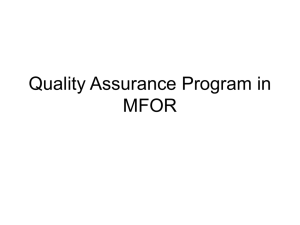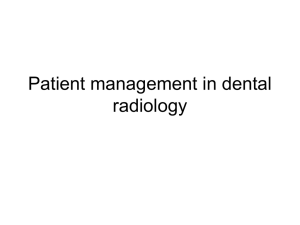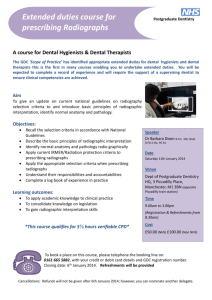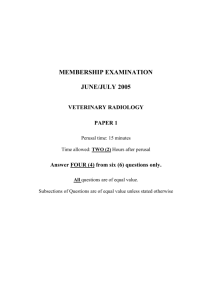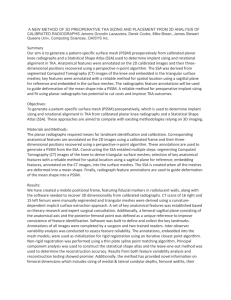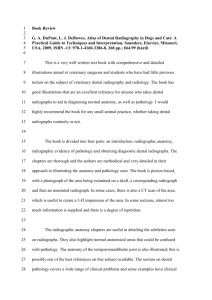Radiolucent lines and component stability in knee arthroplasty
advertisement
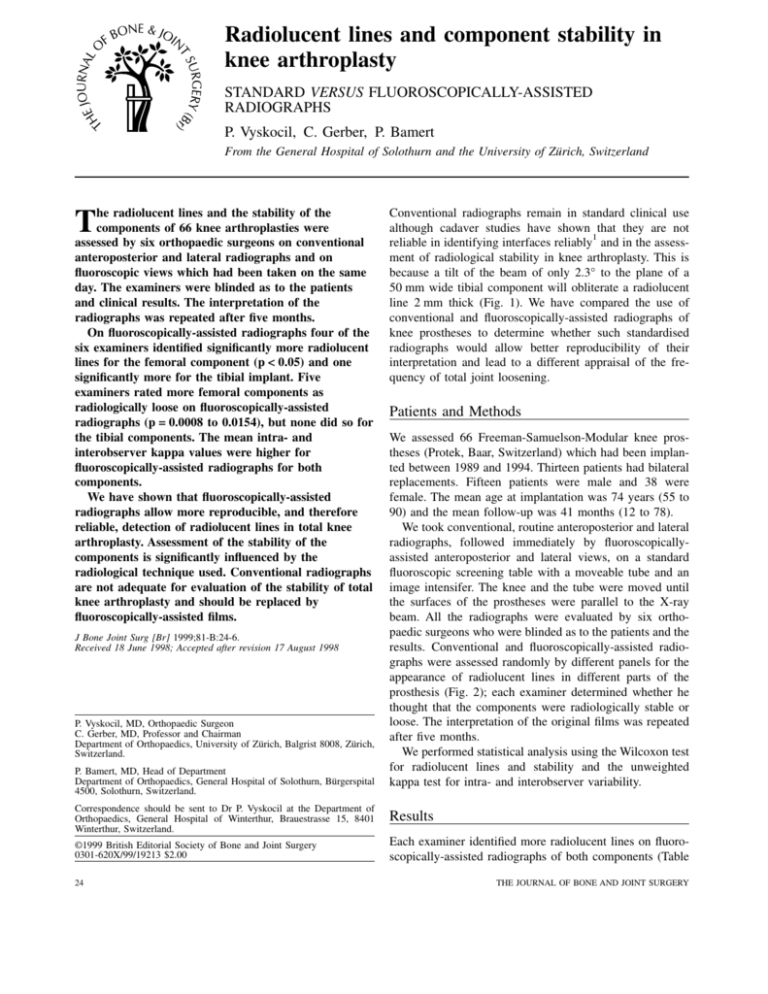
Radiolucent lines and component stability in knee arthroplasty STANDARD VERSUS FLUOROSCOPICALLY-ASSISTED RADIOGRAPHS P. Vyskocil, C. Gerber, P. Bamert From the General Hospital of Solothurn and the University of Zürich, Switzerland he radiolucent lines and the stability of the components of 66 knee arthroplasties were assessed by six orthopaedic surgeons on conventional anteroposterior and lateral radiographs and on fluoroscopic views which had been taken on the same day. The examiners were blinded as to the patients and clinical results. The interpretation of the radiographs was repeated after five months. On fluoroscopically-assisted radiographs four of the six examiners identified significantly more radiolucent lines for the femoral component (p < 0.05) and one significantly more for the tibial implant. Five examiners rated more femoral components as radiologically loose on fluoroscopically-assisted radiographs (p = 0.0008 to 0.0154), but none did so for the tibial components. The mean intra- and interobserver kappa values were higher for fluoroscopically-assisted radiographs for both components. We have shown that fluoroscopically-assisted radiographs allow more reproducible, and therefore reliable, detection of radiolucent lines in total knee arthroplasty. Assessment of the stability of the components is significantly influenced by the radiological technique used. Conventional radiographs are not adequate for evaluation of the stability of total knee arthroplasty and should be replaced by fluoroscopically-assisted films. T J Bone Joint Surg [Br] 1999;81-B:24-6. Received 18 June 1998; Accepted after revision 17 August 1998 P. Vyskocil, MD, Orthopaedic Surgeon C. Gerber, MD, Professor and Chairman Department of Orthopaedics, University of Zürich, Balgrist 8008, Zürich, Switzerland. P. Bamert, MD, Head of Department Department of Orthopaedics, General Hospital of Solothurn, Bürgerspital 4500, Solothurn, Switzerland. Conventional radiographs remain in standard clinical use although cadaver studies have shown that they are not 1 reliable in identifying interfaces reliably and in the assessment of radiological stability in knee arthroplasty. This is because a tilt of the beam of only 2.3° to the plane of a 50 mm wide tibial component will obliterate a radiolucent line 2 mm thick (Fig. 1). We have compared the use of conventional and fluoroscopically-assisted radiographs of knee prostheses to determine whether such standardised radiographs would allow better reproducibility of their interpretation and lead to a different appraisal of the frequency of total joint loosening. Patients and Methods We assessed 66 Freeman-Samuelson-Modular knee prostheses (Protek, Baar, Switzerland) which had been implanted between 1989 and 1994. Thirteen patients had bilateral replacements. Fifteen patients were male and 38 were female. The mean age at implantation was 74 years (55 to 90) and the mean follow-up was 41 months (12 to 78). We took conventional, routine anteroposterior and lateral radiographs, followed immediately by fluoroscopicallyassisted anteroposterior and lateral views, on a standard fluoroscopic screening table with a moveable tube and an image intensifer. The knee and the tube were moved until the surfaces of the prostheses were parallel to the X-ray beam. All the radiographs were evaluated by six orthopaedic surgeons who were blinded as to the patients and the results. Conventional and fluoroscopically-assisted radiographs were assessed randomly by different panels for the appearance of radiolucent lines in different parts of the prosthesis (Fig. 2); each examiner determined whether he thought that the components were radiologically stable or loose. The interpretation of the original films was repeated after five months. We performed statistical analysis using the Wilcoxon test for radiolucent lines and stability and the unweighted kappa test for intra- and interobserver variability. Correspondence should be sent to Dr P. Vyskocil at the Department of Orthopaedics, General Hospital of Winterthur, Brauestrasse 15, 8401 Winterthur, Switzerland. Results ©1999 British Editorial Society of Bone and Joint Surgery 0301-620X/99/19213 $2.00 Each examiner identified more radiolucent lines on fluoroscopically-assisted radiographs of both components (Table 24 THE JOURNAL OF BONE AND JOINT SURGERY RADIOLUCENT LINES AND COMPONENT STABILITY IN KNEE ARTHROPLASTY 25 Fig. 1 A radiolucent line 2 mm thick is obscured on the radiograph if the central beam is tilted 2.3° to a tibial component 50 mm wide ( = invtan 2/50). Table I. Radiolucent lines identified by the six examiners on conventional and fluoroscopically-assisted radiographs for the 66 femoral and tibial components Fig. 2 The different parts of the tibial (a) and femoral (b) component which were assessed for radiolucent lines. I). Four of the six examiners identified significantly more radiolucent lines on these views of the femoral component (p < 0.05) and one on those of the tibial component. Five examiners rated loosening as higher for the femoral component on fluoroscopically-assisted radiographs (p = 0.0008 to 0.015). Conversely, on these no examiner assessed the rate of loosening of the tibial components as higher. Intraobserver and interobserver reliability of evaluation of the stability was better for the fluoroscopically-assisted radiographs for both components (Fig. 3). The mean intraobserver agreement on fluoroscopic radiographs was good for the femoral component, but only moderate for the tibial implant. On conventional radiographs intraobserver agreement for both components was only moderate. The mean interobserver agreement on fluoroscopic radiographs was moderate for the femoral and fair for the tibial component; Fig. 3a Examiner Conventional Fluoroscopicallyassisted Difference Femoral component 1 2 3 4 5 6 161 84 134 157 88 95 193 136 176 197 112 115 32 52 42 40 24 20 Tibial component 1 2 3 4 5 6 93 45 73 53 124 66 114 61 81 61 134 75 21 16 8 8 10 9 on conventional radiographs it was fair for the femoral and poor for the tibial prosthesis with a kappa value of 0.17. Discussion 1 Using a cadaver model, Mintz et al compared plain and fluoroscopically-assisted radiographs in the assessment of knee arthroplasty. They showed that the latter allowed accurate measurement of lucent lines as small as 1 mm, but plain radiographs were inadequate for their detection or measurement. Fluoroscopically-assisted radiographs also allowed measurement of the distance between the tibial component and radiopaque markers in the proximal part of Fig. 3b The mean kappa values for intra- (a) and interobserver (b) variability for stability of the femoral and tibial components on conventional and fluoroscopically-assisted radiographs. VOL. 81-B, NO. 1, JANUARY 1999 26 P. VYSKOCIL, C. GERBER, P. BAMERT the metaphysis which was reproducible to within 0.5 mm. Plain radiographs could not achieve this. They therefore recommended fluoroscopically-assisted radiography for the detection of the presence and progression of radiolucent lines in the tibial component. Our trigonometric calculations (Fig. 1) confirmed that a deviation of the central Xray beam of only 2.3° to the interface (the exact value depending on the width of the prosthesis) is sufficient to obscure a radiolucent line 2 mm wide. This agrees with the 2 findings of Magee and Weinstein who showed that a plain radiograph with a divergence of the central beam of only 3° from a plane parallel to the bone-implant interface will not detect a lucent line of 2 mm beneath the tibial component. 3 Fehring and McAvoy reported that in 14 of 20 patients the diagnosis of aseptic loosening could only be made by fluoroscopically-assisted radiographs. They confirmed the radiological interpretation at surgical revision, thereby showing the clinical relevance of guided radiographs. None the less, conventional radiographs remain the clinical standard although their accuracy for the detection of lucencies is not well established and the reproducibility of the interpretation is uncertain. Our results indicate that assessment of the femoral interface is significantly more sensitive to loosening zones and more reproducible on fluoroscopically-assisted than on conventional radiographs. The lack of a significant difference for the assessment of the stability of the tibial prostheses is, however, surprising since, in comparison with the femoral components, these were rated loose four times less often. There were probably too few radiologically loose components to detect a significant difference. Since our tibial prosthesis had three pegs, for the assessment of three of seven parts of the component conventional radiographs were adequate for the interpretation of stability. There was better intraobserver reliability for the tibia when using fluoroscopically-assisted imaging. Brand, Yoder and Ped4 ersen studied interobserver variability in interpreting lucencies around total hip replacements. All three observers agreed on the assessment of acetabular lucencies in only 26 hips (46%) and disagreed in 8 (13%). They found a significant interobserver variability in interpreting these appearances. The problems with interpreting radiographs which have not been taken in a standard manner and the significance of the definition of ‘loosening’ have been 5 discussed by Brand, Pedersen and Yoder. Our study shows that the same principles apply for total knee arthroplasty. The routine use of fluoroscopically-assisted radiographs could improve sequential supervision of an individual case and substantially improve the interobserver reliability. No benefits in any form have been received or will be received from a commercial party related directly or indirectly to the subject of this article. References 1. Mintz AD, Pilkington CAJ, Howie DW. A comparison of plain and fluoroscopically guided radiographs in the assessment of arthroplasty of the knee. J Bone Joint Surg [Am] 1989;71-A:1343-7. 2. Magee FP, Weinstein AM. The effect of position in the detection of radiolucent lines beneath the tray. Trans Orthop Res Soc 1996;11: 357. 3. Fehring TK, McAvoy G. Fluoroscopic evaluation of the painful total knee arthroplasty. Clin Orthop 1996;331:226-33. 4. Brand RA, Yoder SA, Pedersen DR. Interobserver variability in interpreting radiographic lucencies about total hip reconstructions. Clin Orthop 1985;192:237-9. 5. Brand RA, Pedersen DR, Yoder SA. How definition of “loosening” affects the incidence of loose total hip reconstructions. Clin Orthop 1986;210:185-91. THE JOURNAL OF BONE AND JOINT SURGERY
